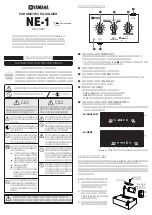
18
Connecting Your Components
Before Making any Connections
• Always refer to the instructions that came with the
component that you are connecting.
• Do not plug in the power cord until all connections
have been properly made.
• Do not bind audio cables with power cords and
speaker cables. Doing so may adversely affect the
sound quality.
• To prevent interference, keep power cords and
speaker cables away from the tuner’s antenna.
AV Connection Color Coding
RCA-type AV connections are usually color coded: red,
white, and yellow. Use red plugs to connect right-
channel audio inputs and outputs (typically labeled “R”).
Use white plugs to connect left-channel audio inputs and
outputs (typically labeled “L”). And use yellow plugs to
connect composite video inputs and outputs.
• Push each plug in all the way to make a good
connection (loose connections can cause noise or
malfunctions).
The receiver’s PHONO input jacks are for use with
moving-magnet (MM) type cartridges.
Use an analog audio cable to connect the receiver’s
PHONO L/R jacks to the audio output jacks on the
turntable, as shown.
Notes:
• If the turntable has a ground wire, connect it to
receiver’s GND terminal. With some turntables,
connecting the ground wire may cause hum, in which
case it should be disconnected.
• If the turntable has a moving-coil (MC) type cartridge,
you’ll need a commercially available MC phono
preamp. In this case, connect the turntable to the
phono preamp’s input, and connect the phono
preamp’s output to the receiver’s PHONO L/R jacks.
Use an analog audio cable to connect the receiver’s CD
L/R jacks to the analog audio output jacks on the CD
player, as shown.
Left (white)
Right (red)
(Yellow)
Analog audio
Composite video
Left (white)
Right (red)
(Yellow)
Wrong!
Right!
Connecting a Turntable
Connecting a CD Player
AUDIO OUT
Ground wire
ANALOG
OUT
















































